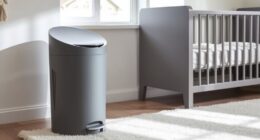If you’re looking to jumpstart your programming journey, I recommend exploring beginner-friendly coding robots like the Teach Tech Mech 5, Botley, Evo Entry Kit, mBot, and Sphero Bolt+. These options offer a mix of hands-on assembly, visual programming, and sensor features suitable for various ages. Whether you want screen-free coding or more advanced setup, there’s something here for everyone. Keep exploring, and you’ll discover even more tools to turn your ideas into reality.
Key Takeaways
- The list includes beginner-friendly robots like Botley, Teach Tech Mech 5, and Sphero Bolt+ that promote early coding skills.
- It features versatile kits such as Makeblock mBot and EVO Entry Kit suitable for various age groups and skill levels.
- Emphasis on robots with simple assembly, intuitive programming options, and educational resources for effective learning.
- Highlights durability, water resistance, and portability for active and creative STEM activities.
- Provides insights into pros, cons, and technical features to help beginners choose suitable coding robots.
Teach Tech Mech 5, Mechanical Coding Robot
If you’re looking for an entry-level coding robot that combines hands-on learning with eco-friendly features, the Teach Tech Mech 5 is an excellent choice for beginners aged 10 and up. This mission-based STEM robot lets kids throw, lift, kick, draw, and move in various directions by snapping coding buttons onto a wheel. It’s easy to assemble, making it perfect for young engineers, and runs on water, wind, or sun—no batteries needed. Its compact design and simple coding system make learning engaging and accessible, helping kids develop mechanical skills and basic programming while fostering creativity. It’s a fun, eco-friendly way to introduce kids to robotics and STEM concepts.
Best For: beginners aged 10 and up who want an eco-friendly, hands-on STEM coding robot to develop mechanical skills and creativity.
Pros:
- Easy to assemble with detailed instructions, suitable for young engineers
- Eco-friendly power source using water, wind, or sun, eliminating batteries
- Versatile functions like throwing, lifting, kicking, drawing, and moving in multiple directions
Cons:
- Assembly can be time-consuming and may require adult assistance
- Some users find the coding system simplistic, limiting advanced programming options
- Smaller parts and tools might pose a challenge for very young children or those with limited dexterity
ELEGOO UNO R3 Robot Car Kit V4 for Arduino STEM Robotics for Kids and Teens
Looking for a robotics kit that balances hands-on learning with programming flexibility? The ELEGOO UNO R3 Robot Car Kit V4 is perfect for kids and teens enthusiastic to explore robotics and coding. It includes 24 modules like obstacle avoidance, line tracing, and Wi-Fi control, with simple assembly thanks to XH2.54 ports. The kit supports block-based coding and advanced Python programming, making it suitable for beginners and intermediate users. While setup can be tricky, especially with software updates and troubleshooting, it offers excellent customization options, camera streaming, and app control. Overall, it’s a versatile, educational kit that fosters creativity and technical skills.
Best For: beginners and intermediate kids and teens interested in hands-on robotics, programming, and electronics exploration.
Pros:
- Supports both block-based and Python programming for versatile learning.
- Includes a comprehensive set of modules like obstacle avoidance, line tracing, and Wi-Fi control.
- Easy assembly with XH2.54 ports and detailed instructions, making setup accessible.
Cons:
- Software setup and firmware updates can be challenging and require troubleshooting.
- Initial configuration may lead to wheelies or spins without fine-tuning.
- Complex firmware and code may overwhelm complete beginners and require programming experience.
Learning Resources Botley Coding Robot for Kids
The Learning Resources Botley Coding Robot for Kids stands out as an ideal choice for beginners aged 5 and up, thanks to its screen-free programming approach. I find it perfect for early learners because it uses remote controls, coding cards, and visual prompts, making coding accessible without a screen. With features like 80-step programming, loops, obstacle detection, and interactive lights and sounds, it promotes critical thinking and problem-solving. The 45-piece activity set offers endless opportunities for creative challenges. I’ve seen how kids enjoy programming Botley to navigate various obstacles, helping them develop logical sequencing and STEM skills in a fun, hands-on way.
Best For: young children aged 5 and above who are beginning to explore coding in a screen-free, hands-on way.
Pros:
- Encourages critical thinking, problem-solving, and logical sequencing through interactive play.
- Offers versatile features like remote programming, obstacle detection, and customizable obstacle courses.
- Easy to use out-of-the-box with engaging lights, sounds, and detachable accessories to keep children captivated.
Cons:
- Requires 5 AAA batteries (not included), which may be an inconvenience for some users.
- May have limited advanced programming capabilities for older or more experienced coders.
- The 45-piece activity set, while versatile, might be too small for larger groups or extensive play sessions.
Evo Entry Kit: Interactive Coding Robot for Kids
The Evo Entry Kit stands out as an excellent choice for young children just starting their coding journey because it combines both screen-free and digital learning methods. It includes the Evo robot, markers, a charging cable, and a sturdy zip case, making it perfect for classroom or home use. With over 700 STEM lessons and five skill levels, it supports kids from beginner to advanced. You don’t need prior experience—just follow the easy Get Started guide. Whether through Color Codes or Blockly programming, this kit offers engaging, long-term learning that fosters critical thinking, problem-solving, and a love for STEM. It’s a versatile, durable option for growing young coders.
Best For: young children and educators seeking a versatile, engaging, and long-term introduction to coding and STEM learning through both screen-free and digital methods.
Pros:
- Supports multiple skill levels from beginner to advanced, ensuring continuous growth
- Includes a comprehensive set of over 700 STEM lessons for diverse, engaging activities
- Durable design with portable accessories makes it ideal for classroom and home use
Cons:
- May require some initial guidance for educators new to robotics education
- The cost could be higher compared to simpler, less feature-rich alternatives
- Some children may need additional encouragement to explore Blockly programming beyond Color Codes
Makeblock mBot Robot Kit for Kids Ages 8-12 STEM Toy (Scratch & Arduino)
If you’re seeking an easy-to-assemble, beginner-friendly robot kit that combines coding with hands-on building, the Makeblock mBot Robot Kit is an excellent choice for children aged 8 to 12. This STEM toy introduces electronics, robotics, and programming through Scratch and Arduino, making it perfect for novices. Its modular design allows for extensive customization with over 100 electronic modules, 500 parts, and LEGO compatibility. The kit is durable, quick to assemble, and packed with features like obstacle avoidance and line-following. Rich tutorials and user-friendly apps help kids learn coding concepts in a fun, interactive way, fostering creativity and problem-solving skills.
Best For: children aged 8-12 who are beginners in electronics, robotics, and programming looking for an engaging, easy-to-assemble STEM kit.
Pros:
- User-friendly assembly process suitable for beginners with clear instructions and quick setup
- Versatile and expandable, compatible with over 100 modules, 500 parts, and LEGO pieces for customization
- Rich educational resources including tutorials, coding cards, and app-based lessons that promote hands-on learning
Cons:
- Software and app may require troubleshooting or basic electronics knowledge for some users
- Advanced projects and customization might necessitate additional parts or prior knowledge
- Slightly limited to entry-level features, which may not satisfy users seeking more complex robotics capabilities
Sphero Bolt+ Coding Robot Ball for Kids & Teens
Sphero Bolt+ stands out as an ideal choice for kids and teens enthusiastic to explore coding through a durable, interactive robot ball. Its waterproof design and polycarbonate shell make it tough enough for active play and artistic projects, like dipping in paint or steering water. With a vivid LCD screen, it displays animations, graphics, and sensor data, fueling creativity. It supports multiple programming methods—Draw, Block, and Javascript—via the free Sphero Edu app, making it perfect for beginners and advanced users. Its sensors, long battery life, and easy wireless charging ensure engaging, extended learning sessions, whether at home or in the classroom.
Best For: kids and teens eager to learn coding through a durable, water-resistant robot ball that offers creative, hands-on STEM activities.
Pros:
- Supports multiple programming methods (Draw, Block, Javascript) suitable for all skill levels
- Waterproof and durable polycarbonate shell ideal for active and artistic play
- Long battery life with wireless Qi charging for extended, uninterrupted use
Cons:
- Initial setup and pairing can be challenging for some users
- Higher price point compared to basic or less feature-rich robots
- Requires a compatible device with the Sphero Edu app, which may limit accessibility for some users
Learning Resources Code & Go Robot Mouse – 31 Pieces
Designed for young children aged 4 and up, the Learning Resources Code & Go Robot Mouse stands out as an ideal starter kit for beginners interested in screen-free coding. Its colorful 4-inch robot features intuitive directional buttons and 30 double-sided coding cards, making it easy for kids to create step-by-step sequences. The robot lights up, makes sounds, and moves at two speeds, providing immediate visual and auditory feedback. This engaging toy promotes problem-solving, critical thinking, and logical reasoning while introducing foundational coding concepts like sequencing and route planning. It’s perfect for hands-on learning, fostering early STEM skills in a fun, accessible way outside screens.
Best For: young children aged 4 and up who are beginning to explore screen-free coding, problem-solving, and STEM activities in a fun and engaging way.
Pros:
- Introduces foundational coding concepts through intuitive buttons and coding cards, making it easy for beginners.
- Provides immediate visual and auditory feedback to keep children engaged and motivated.
- Promotes critical thinking, problem-solving, and logical reasoning outside of screen time.
Cons:
- Requires 3 AAA batteries, which are not included, adding an extra step for setup.
- Limited to basic directional commands, which may not suit more advanced learners.
- The 4-inch size might be less suitable for very young children who prefer larger, more tactile toys.
Makeblock mBot2 Coding Robot for Kids
The Makeblock mBot2 Coding Robot for Kids stands out as an excellent choice for children aged 8-12 who want to learn coding with ease and versatility. It supports both Scratch and Python, making it suitable for beginners and more advanced learners. With over 10 sensors, expandable modules, and AI features like weather inquiry and light effects, it offers endless interactive possibilities. Control options include Bluetooth, USB, and Wi-Fi, and the rechargeable battery lasts up to 5 hours. Designed for quick assembly and user-friendly programming, this robot keeps kids engaged while building essential STEM skills in a fun, intuitive way.
Best For: children aged 8-12 interested in starting or advancing their coding and robotics skills in a fun, interactive way.
Pros:
- Supports both Scratch and Python programming for versatile learning.
- Equipped with 10+ sensors and expandable modules for diverse projects.
- Easy to assemble and control via Bluetooth, Wi-Fi, or USB, with a rechargeable battery for extended use.
Cons:
- Some users find the cables and connectors less child-friendly.
- The assembly instructions may pose minor challenges for younger children or beginners.
- The robot’s features and software updates may require ongoing learning and adaptation.
WhalesBot Rocky Smart Robot Car Coding & Remote Control Kit for Kids
If you’re looking for a versatile coding robot suitable for kids aged 8 to 16, WhalesBot Rocky stands out with its multiple modes and advanced sensors. It offers remote control, automatic, coding, and DIY modes, making it engaging and educational. Equipped with 5-in-1 grayscale sensors and closed-loop motors, Rocky handles line following, obstacle avoidance, and light detection effectively. The kit encourages creativity through hands-on building and programming in Scratch, Python, and C, with step-by-step guides in the WhalesBot app. Its modular design supports various projects, fostering curiosity and logical thinking. Rocky is an excellent choice for young learners enthusiastic to explore robotics and coding.
Best For: children aged 8-16 who are interested in learning robotics, programming, and STEM activities through hands-on building and coding experiences.
Pros:
- Supports multiple modes including remote control, automatic, coding, and DIY for versatile play.
- Equipped with advanced sensors such as 5-in-1 grayscale sensors and closed-loop motors for complex tasks like obstacle avoidance and line following.
- Offers beginner-friendly programming options in Scratch, Python, and C with step-by-step guides via the WhalesBot app, fostering creativity and learning.
Cons:
- Assembly instructions, especially for wiring motors, may require additional guidance for clarity.
- Pre-programmed obstacle avoidance features might need customization for optimal performance.
- The software interface can be complex for some users, requiring patience and practice to master all features.
Robot Arm for Arduino, Smart Robot Building Kit
For beginners interested in robotics and programming, the Robot Arm for Arduino, Smart Robot Building Kit offers an engaging hands-on experience. It includes hardware to build a 4-axis robotic arm capable of grabbing objects in multiple directions, with joints that rotate up to 260°, 180°, and more. You can control it via joystick or program commands, and it can memorize up to 170 actions. The kit features high-quality laser-cut acrylic parts and spare hardware. While assembly takes around 5-6 hours and can be tricky, it’s rewarding and educational. Keep in mind, wiring may require troubleshooting, and safety precautions are essential due to rapid homing.
Best For: hobbyists, students, and beginners interested in learning robotics, electronics, and programming through hands-on building and experimentation.
Pros:
- Engages users with a fun, educational DIY project that enhances skills in electronics, coding, and mechanics
- Includes high-quality, durable components like laser-cut acrylic parts and spare hardware for reliable assembly
- Capable of memorizing up to 170 actions, allowing for programmable automation and repeated routines
Cons:
- Assembly can be time-consuming and may require patience, with some parts challenging to fit or assemble correctly
- Wiring diagrams and programming instructions are insufficiently detailed, leading to potential troubleshooting for beginners
- Compatibility issues with the included Arduino Nano clone and safety concerns due to rapid homing behavior upon startup
Learning Resources Botley The Coding Robot 2.0 Activity Set
Designed for young children enthusiastic to explore coding without screens, Botley 2.0 The Coding Robot 2.0 Activity Set stands out as an excellent choice for beginners. This award-winning, 78-piece set includes a robot, remote programmer, coding cards, obstacle pieces, and more, making learning engaging and hands-on. It introduces core coding concepts like sequences, loops, and if/then logic through multiple methods, such as color coding and movement directions. With object detection technology, Botley can handle increasingly complex challenges. Its versatility allows kids to build programs up to 150 steps, follow lines, and navigate obstacles, fostering critical thinking and problem-solving skills in a fun, accessible way.
Best For: young children ages 5 and up who are eager to learn coding and STEM skills through hands-on, screen-free play.
Pros:
- Encourages early STEM learning by teaching coding concepts like sequences, loops, and conditional logic without screens.
- Durable and easy to use, suitable for repeated play and long-term use.
- Offers versatile play options including line following, obstacle navigation, and transforming robot modes to keep children engaged.
Cons:
- Some users report initial challenges with programming angles or understanding instructions.
- Requires 5 AAA batteries, which are not included, adding to setup considerations.
- Occasional product defects or difficulties in customer support have been noted by a few users.
Dash Robot – Coding Robot for Kids 6
The Dash Robot stands out as an ideal choice for kids aged 6 and up who are just beginning to explore coding through hands-on play. It’s ready to use right out of the box, with no assembly needed, and includes fun accessories like building brick connectors. Dash can sing, dance, navigate obstacles, respond to voice commands, and change LED colors, making learning interactive and engaging. Its app-based programming supports various skill levels, from simple drag-and-drop to complex commands. Durable and responsive, Dash offers up to five hours of play, making it perfect for beginners enthusiastic to develop foundational coding skills in a playful, intuitive way.
Best For: kids aged 6 and up who want an engaging, programmable STEM toy that fosters creativity and foundational coding skills through hands-on play.
Pros:
- Ready to use straight out of the box with no assembly required
- Supports multiple coding apps and skill levels, from drag-and-drop to complex commands
- Durable, responsive, and capable of obstacle navigation and interactive features like singing and dancing
Cons:
- Limited to no camera functionality for visual-based activities
- Some users desire more advanced code export and firmware update guidance
- Accessories and attachments may add to overall cost for expanded features
Educational Insights PYXEL Coder’s Robot for Kids (Ages 8+)
Educational Insights PYXEL Coder’s Robot for Kids stands out as an excellent choice for children ages 8 and up who are just starting to explore coding and robotics. This adorable robotic dog makes learning engaging with actions, tricks, expressions, colors, and sounds. It supports beginner-friendly Blockly and Python programming languages, making it suitable for various skill levels. No internet or app needed—just connect via Wi-Fi to tablets or computers. The kit includes a rechargeable battery, USB-C cord, and user guide. PYXEL offers hands-on STEM learning through interactive tutorials, helping kids build coding skills while having fun with a cute, responsive robot.
Best For: children aged 8 and above who are interested in starting or advancing their coding and robotics skills through interactive, hands-on learning.
Pros:
- Supports beginner to advanced coders with Blockly and Python programming languages.
- No internet or app required, making it easy to set up and use anywhere.
- Includes engaging features like lights, sounds, tricks, and expressions to make learning fun and interactive.
Cons:
- Customer ratings are moderate at 3.8/5 stars, indicating some users may experience issues.
- Price and availability can vary, potentially affecting accessibility.
- Requires 2 AAA batteries for operation, which are not included.
Educational Insights Artie 3000 Coding Robot Drawing STEM Toy
If you’re looking to introduce kids aged 7 and up to coding through a hands-on, creative experience, the Artie 3000 Coding Robot Drawing STEM Toy is an excellent choice. Kids can program it in four languages—Blockly, Snap!, JavaScript, and Python—and watch it produce colorful drawings. It’s easy to set up, connecting via Wi-Fi without the need for apps or internet, making it secure and user-friendly. With pre-programmed shapes and options for custom designs, Artie sparks creativity while teaching essential coding skills. It’s perfect for both classroom and home use, blending learning and fun in an engaging way.
Best For: children aged 7 and up who are interested in learning coding, robotics, and art through a fun, hands-on STEM experience.
Pros:
- Supports coding in four different languages—Blockly, Snap!, JavaScript, and Python—catering to various skill levels.
- Easy to set up with a secure Wi-Fi connection, no need for apps or internet, making it user-friendly and safe.
- Encourages creativity and problem-solving through customizable drawings and pre-programmed shapes.
Cons:
- Some users experience connectivity issues or firmware incompatibilities, which can hinder the setup process.
- Limited control options, primarily relying on web browser interfaces, may be less intuitive for some users.
- Occasional hardware malfunctions like unresponsive motors or Wi-Fi failures can require troubleshooting or returns.
BirdBrain Finch Robot 2.0 with Microbit STEM Coding Robot Kit
Designed for ages 5 to 16, the BirdBrain Finch Robot 2.0 with Microbit STEM Coding Kit stands out as an excellent choice for both beginners and more experienced learners. It offers a compact, portable platform that introduces coding, robotics, and Python programming through engaging tutorials and multi-language support, including MakeCode, Snap, and Java. With sensors for obstacle detection, line tracking, and light, it encourages hands-on exploration and problem-solving. Compatibility with various devices and Bluetooth control makes it versatile for classroom or home use. Plus, its long-lasting battery guarantees extended projects, making it a reliable tool to jumpstart your coding journey.
Best For: learners aged 5 to 16 who want an engaging, versatile, and educational robotics platform to explore coding, robotics, and Python programming with hands-on activities and multi-device compatibility.
Pros:
- Supports multiple coding languages including MakeCode, Snap, Python, Java, Swift, and Kotlin, catering to all skill levels.
- Equipped with sensors like obstacle detection, line tracking, and light sensors for interactive, real-world applications.
- Long-lasting battery life of over 7 hours allows for extended projects and continuous learning sessions.
Cons:
- The product may require some initial setup and familiarity with coding platforms for beginners.
- Slightly higher price point compared to basic robots, which might be a consideration for budget-conscious buyers.
- Limited availability of advanced features for users seeking more complex or programmable hardware beyond the provided tutorials.
Factors to Consider When Choosing Coding Robots for Beginners

When selecting a coding robot for beginners, I consider factors like age appropriateness and programming complexity to make certain it’s suitable and challenging enough. Build quality and ease of assembly are also important, as they affect durability and the learning experience. Additionally, I look at the educational content to make sure it offers meaningful lessons that keep learners engaged.
Age Appropriateness
Choosing the right coding robot depends heavily on the child’s age, as different developmental stages require different features and complexity levels. Ensuring the robot’s recommended age range aligns with your child’s age helps match their cognitive and motor skills. For younger children (ages 4-7), look for robots with simple, button-based programming, large buttons, and durable designs that fit small hands. Safety features and lightweight construction are essential at this stage. As kids grow older (8+), they can handle more advanced programming environments and features that expand their skills. For teens, select robots supporting sophisticated coding languages and offering expandable features to keep them challenged. Matching the robot’s complexity to your child’s age promotes engagement, learning, and confidence in their programming journey.
Programming Complexity
Selecting a coding robot for beginners means prioritizing simplicity in its programming environment. I recommend choosing one with drag-and-drop block coding, which lowers the barrier to entry and makes learning fun. The programming language should match the learner’s skill level, starting with visual blocks before moving to text-based coding as confidence grows. Clear, step-by-step tutorials or guided activities are essential to help beginners grasp concepts without feeling overwhelmed. A good robot offers multiple programming modes, from basic commands to more advanced scripting, allowing gradual skill development. Additionally, intuitive controls and immediate visual feedback are vital—they reinforce learning, make troubleshooting easier, and keep beginners motivated. Overall, simplicity and guided learning are key to a successful programming experience for beginners.
Build Quality
A robot’s build quality plays a crucial role in its suitability for beginners, as it guarantees durability and ease of use. High-quality materials assure the robot can handle frequent handling and repeated assembly without breaking down. Precise assembly instructions and well-fitting components make the building process smoother, reducing frustration. Sturdy joints and secure connectors prevent parts from loosening or breaking during operation, extending the robot’s lifespan. Compatibility with additional modules or expansion kits adds to the robot’s versatility and longevity. Clear labeling and detailed wiring diagrams are essential for beginners, simplifying assembly and troubleshooting. Overall, a well-constructed robot provides a reliable, frustration-free experience, encouraging learners to explore and experiment confidently. These build qualities are fundamental in choosing a robot that’s both durable and beginner-friendly.
Educational Content
When evaluating educational content in coding robots for beginners, it’s crucial to guarantee the lessons are tailored to the learner’s age and skill level. This ensures the material is engaging and promotes effective understanding. I look for robots that support multiple programming languages, like block-based coding for novices and text-based options such as Python or Java to encourage progression. Clear, step-by-step instructions, challenges, and projects are essential for hands-on learning and keeping learners motivated. Supplementary resources like activity guides, lesson plans, or online tutorials help reinforce concepts outside the device. Additionally, I consider whether the curriculum covers fundamental coding principles like sequences, loops, conditionals, and problem-solving, which build a solid programming foundation for beginners.
Ease of Assembly
Choosing a coding robot that’s easy to assemble can make a significant difference in a beginner’s learning experience. I look for models that come pre-assembled or require minimal building, so I can start coding sooner. Clear, detailed instructions with visual guides are essential—they help reduce confusion and make assembly straightforward. I also check if the kit includes necessary tools like screwdrivers or connectors, which saves time and frustration. Minimal wiring and simple hardware connections are preferable, as complicated setups can be discouraging. In conclusion, I consider whether the assembly process matches my skill level, favoring options with step-by-step support designed for beginners. An easy-to-assemble robot keeps the focus on learning programming, rather than struggling with construction.
Cost and Budget
Budget plays a crucial role in selecting the right coding robot for beginners, as prices can vary widely from around $30 to over $200. Setting a clear budget helps narrow down options that teach essential coding skills without overspending. Consider the long-term value and durability of the robot relative to its cost to guarantee it’s a worthwhile investment. Cheaper models typically focus on basic programming and simple controls, while higher-priced options may include sensors, app integration, and more advanced features. Comparing prices across retailers and looking for discounts or bundles can maximize your budget’s value. By understanding your needs and financial limits, you can find a coding robot that offers great learning opportunities without breaking the bank.
Expandability Options
Expanding a coding robot’s capabilities can substantially enhance the learning experience, making it more engaging and versatile. When choosing a robot, I look for models with modular components or add-on kits that let me upgrade sensors, attachments, or functionalities over time. It’s vital to verify if the software supports programming these additional modules or integrating with other devices, opening up more learning possibilities. Compatibility between expansion options, hardware, and software is key to ensure seamless upgrades without frustration. I also prefer products that offer a variety of expansion kits or community-created add-ons, which boost customization and creativity. Ultimately, clear guidance, instructions, or resources from the manufacturer help me confidently modify and expand the robot as my skills grow.
Software Compatibility
When selecting a coding robot for beginners, ensuring that its software is compatible with the devices you have is essential. I recommend checking if the robot supports your PC, tablet, or smartphone to avoid any connectivity issues. It’s also helpful to choose robots that support multiple programming environments, like block-based and text-based coding, to facilitate a gradual learning curve. Make sure the software is regularly updated and maintained, so it stays compatible with the latest operating system versions. Cross-platform support—covering Windows, macOS, Android, and iOS—is a big plus for accessibility. Lastly, opt for software with user-friendly interfaces and all-encompassing tutorials, which make the learning process smoother and more engaging for beginners.
Frequently Asked Questions
What Age Range Is Best for Beginner Coding Robots?
I believe the best age range for beginner coding robots is around 6 to 12 years old. At this stage, kids are curious and enthusiastic to learn, making it easier for them to grasp basic programming concepts through hands-on activities. These robots are designed to be user-friendly, with simple interfaces and engaging challenges that help young learners develop problem-solving skills while having fun.
Do Coding Robots Require Prior Programming Experience?
No, coding robots don’t require prior programming experience. I’ve seen beginners jump right in and start coding with minimal guidance, thanks to user-friendly interfaces and step-by-step tutorials. These robots are designed to teach programming concepts gradually, making it accessible for newcomers. So, whether you’re a complete novice or someone with basic tech skills, you can definitely get started without any prior experience.
Are Coding Robots Compatible With Tablets or Smartphones?
Yes, many coding robots are compatible with tablets and smartphones, making them highly accessible. Did you know that over 75% of educational robots now support mobile devices? I find it exciting because it means you can start coding anytime, anywhere. These robots often use dedicated apps that are easy to install and navigate, so you don’t need advanced tech skills. It’s a perfect way to make learning programming fun and portable!
How Durable Are These Robots for Classroom Use?
These coding robots are generally quite durable for classroom use, built to withstand daily handling by students. I’ve seen them endure drops, spills, and rough play without major issues. Manufacturers often design them with sturdy materials to guarantee longevity, making them a reliable choice for active learning environments. While no device is entirely indestructible, these robots are definitely tough enough to handle the rigors of a busy classroom setting.
Can These Robots Be Expanded With Additional Accessories?
Yes, these robots can be expanded with additional accessories. I’ve found that many models offer modular components like sensors, motors, and connectors, allowing you to customize and enhance their capabilities. This flexibility makes learning more engaging and helps you develop a deeper understanding of robotics. Just make sure to check compatibility before purchasing extra accessories, so you can seamlessly integrate them into your setup and keep your projects evolving.
Conclusion
Starting with coding robots might seem overwhelming at first, but I promise it’s easier than you think. These kits are designed to be beginner-friendly, so don’t worry about your experience level. Just pick one that excites you, and jump right in! Remember, the key is to have fun and learn at your own pace. Before you know it, you’ll be creating your own robotic projects with confidence.


























